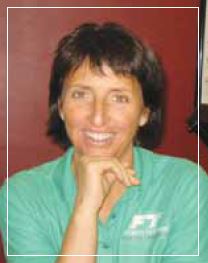WHAT IS BALANCE?
 by Paula Allia
by Paula Allia
PT, DHSc, MTC, OCS
What is balance? It is such a relative term. In the new year, balance could mean eating the right foods.
Another would say it is coordinating proper foods with the right amount of exercise. Yet another just wants plain old balance. Everybody needs balance in each of the above-mentioned areas but for this month, tune in to your balance and perform the activities that you desire; this is key to you being confident and expanding your capabilities.
Balance in the body is when one can maintain their center of gravity within their base of support. In order to understand this, imagine that you have a square box with equal weight throughout the box.
In this instance the center of gravity is exactly in the middle. If you pushed the box slowly over the edge of a table, the box would not fall off until more weight was over the edge versus on the table. Fortunately our bodies are not square but the center of gravity for us is thus harder to understand. Typically, if your center of gravity falls too far outside of your base of support, the body cannot sustain the upright posture and one will stumble and or fall.
In most adults, the center of gravity of the body is in front of the 2nd sacral level of the spine below the lumbar vertebrae. This is where the concentration of weight is, but understand that the center of gravity may lie outside of your physical body limits depending upon what positions are assumed. If you are top heavy the center of gravity may shifts upwards. If you are missing a limb, your center of gravity will shift towards the side with two limbs and up or down depending upon which limb is missing. Even if a person suffers a stroke or has paralysis on one side, the center of gravity may shift away from the weaker side. If this occurs, muscles and ligaments must contribute extra forces to help stabilize you to be successful in a particular position.
Imagine that if you bend too far forward that your body cannot use its forces to stay upright; one would fall forward. Thus understanding gravity and center of gravity are key components to being successful in participatory actions.
If a person bends forward, their center of gravity shifts forward. When bending to the side, the center of gravity shifts toward that side. The body, through the nervous system, combined with visual and auditory input with resultant responses of the neuromuscular system attempt to keep the body in equilibrium and maintain balance. It is a coordinated effort from joint and muscle sensors that feed the brain the proper information so that movement can be complete in a balanced fashion.
Many people do not realize all of the body’s interactions that occur in everyday activities. In even a simple task like rising from a chair, if the leg muscles are weak, one may lean far forward or swing their arms to gain momentum to stand. This compensation goes unrecognized initially. It is only when one loses these abilities is the deficit recognized. The other time that coordinated efforts are evident is when someone does a new task or one that is not done to often; for some these tasks are simple and others relatively impossible. The new activity may appear uncoordinated but with a little practice, suddenly the body gets it (like walking with crutches for the very first time).Remember that the body is an amazing machine that wants to maintain the ability to heal itself and to participate in movement. System balances are key components to this success.
If you are lucky, your body has athleticism and adaptations to learning new skills are easy. Practice can then only make you better. If you are more challenged either by less coordination or from an injury or illness, a more concentrated effort is necessary to achieve desired success in activities. In both instances, understanding your balance point will help your body awareness.
A major cause of not being balanced in an activity can be a deficit in strength but not strength alone. Once you can strengthen muscles that for some reason have been inhibited and thus weakened it is then most important for the nervous system adaptively make corrections to stay within your stable base of support to activate and allow. The key then is for adaptations to become unconscious but initially a lot of cognitive control(function) may be necessary.
In summary, in order to have good balance one first needs to strengthen the appropriate muscles. As the muscles are firing, neuromuscular reeducation for proper coordination need to be stimulated. Finally, the body can coordinate these systems to fire when needed for flawless execution to reach your maximal potential. Most never test themselves to know just how much better they canbe. A trained eye can help but only if you are willing to do the work.
To your Health!
Fitness Together
335 14th Ave South
Naples, FL 34102
239.263.9348
FitnessTogether.com/Naples



Leave a Reply
Want to join the discussion?Feel free to contribute!